K53 Information Signs
Information road signs provide essential guidance and details to road users about destinations, facilities, and services. Understanding these signs is crucial for efficient navigation and is an important part of the K53 learner's license test in South Africa.
Common Information Signs in South Africa

Bus Stop for All Buses
Indicates a bus stop that can be used by all bus services.

Mini-Bus Stop for Authorised Mini-Buses with Line Number
Indicates a mini-bus stop for a specific line number.

Right of Way
Indicates which direction has the right of way at an intersection.

Bus Stop Ahead
Indicates that there is a bus stop ahead.

Bus Stop for Authorised Buses with Line Number
Indicates a bus stop for specific bus lines only.

Dead End (Type 1)
Indicates that the road ahead has no exit.

Dead End (Type 2)
Indicates a more complex dead end situation.
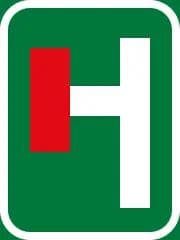
Dead End (Type 3)
Indicates a dead end with a specific layout.
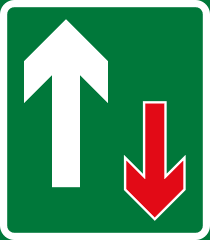
Right of Way Over Oncoming Vehicles
Indicates that drivers have priority over oncoming traffic.
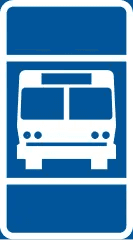
Bus Stop
Marks the location of a bus stop.

Co-ordinated Traffic Signals at Indicated Speed
Informs drivers of the speed for synchronized traffic lights.

Bus Stop for Authorised Buses with Line Numbers
Indicates a bus stop for multiple specific bus lines.

Information Centre
Indicates the location of an information centre.

Mini-Bus Stop for Authorised Mini-Buses with Line Numbers
Indicates a mini-bus stop for multiple specific line numbers.
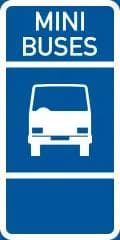
Mini-Bus Stop
Marks the location of a mini-bus stop.
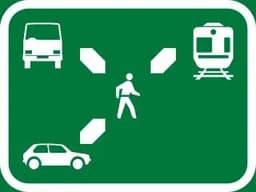
Modal Transfer Point
Indicates a point where travelers can switch between different modes of transport.
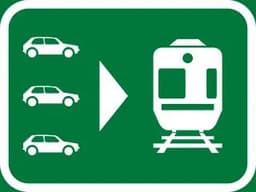
Park and Ride
Indicates a facility where drivers can park their cars and continue their journey by public transport.
Understanding Information Road Signs
Information road signs are designed to guide road users and provide helpful information about routes, destinations, and available services. Unlike regulatory or warning signs, they don't impose rules or warn of hazards but offer valuable guidance. Key features of information road signs include:
- Rectangular or square shape
- Usually blue or green background for guidance signs
- Brown background for tourism signs
- White or yellow text and symbols
- No red borders (unlike warning or regulatory signs)
Information signs cover a wide range of topics, from direction and distance to nearby facilities and points of interest. They play a crucial role in helping drivers navigate efficiently and safely.
Importance of Information Road Signs in South African Driving
Information road signs are vital for several reasons in the South African context:
- Navigation: They help drivers find their way to destinations, especially in unfamiliar areas.
- Traffic Management: By guiding drivers to their destinations efficiently, they help reduce congestion and unnecessary travel.
- Safety: Information about upcoming routes or exits allows drivers to prepare in advance, reducing last-minute lane changes or turns.
- Tourism: Brown tourism signs help visitors locate attractions and services, supporting the tourism industry.
- Emergency Services: Signs indicating hospitals, police stations, and other emergency services can be crucial in times of need.
- Facility Information: Signs indicating rest areas, fuel stations, and other amenities help drivers plan their journeys effectively.
Understanding information signs is essential for navigating South Africa's road network efficiently and safely, making it an important component of the K53 driving system.
Tips for Understanding and Using Information Road Signs
To effectively use information road signs for better navigation:
- Familiarize yourself with the color coding: blue for freeways, green for normal roads, and brown for tourism.
- Pay attention to distance indicators on direction signs to plan your route effectively.
- Look out for exit numbers on freeways, which can help you navigate more easily.
- Use service signs to plan rest stops and refueling on long journeys.
- Remember that some information signs may use symbols instead of text, especially for international consistency.
- When planning a trip, research the tourism signs for your destination to easily locate attractions.
- Practice identifying different types of information signs using the K53 Learners App to improve your recognition skills.
Frequently Asked Questions about Information Road Signs
Why are some information signs blue and others green?
In South Africa, blue signs are typically used on freeways, while green signs are used on other major roads. This color coding helps drivers quickly understand the type of road they are on or being directed to.
What do the brown information signs indicate?
Brown signs are used for tourism and recreational information. They direct drivers to points of interest such as historical sites, natural attractions, or cultural venues.
Are information signs tested in the K53 learner's license exam?
Yes, knowledge of information signs is part of the K53 learner's license test. While they don't carry the same regulatory weight as other signs, understanding them is crucial for safe and efficient driving.
How can I distinguish between local and long-distance destinations on direction signs?
Generally, long-distance destinations are shown at the top of direction signs, while more local destinations are listed below. The signs also usually include distances to help you gauge how far away each destination is.